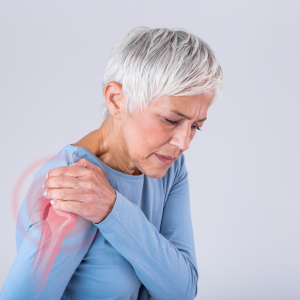While many people refer to the shoulder as just the arm attachment to the shoulder blade, there are actually 4 joints that make up the shoulder complex as it is sometimes described. Two of these are the attachments of the collarbone to the chest bone and at the other end to the shoulder blade itself, and the other joint is the connection between the shoulder blade and the rib cage. All 4 joints need to be working well to ensure that the shoulder can move in the thousands of different positions that this mobile joint is designed to move.
The main stabilising muscles in the shoulder are a group of 4 muscles called the rotator cuff muscles. Three of the rotator cuff muscles sit on the back of the shoulder blade and wrap around the back of the shoulder. These muscles keep the arm and shoulder blade bones together as the arm moves and rotate the shoulder externally (the movement required to scratch your upper back). The other lone rotator cuff muscle sits on the inside of the shoulder blade (between the rib cage and shoulder blade) and wraps around the front of the arm. While it also keeps the arm and shoulder blade bones together, it is an internal rotator of the arm (the movement required to reach behind and scratch your lower back). By the age of 70, approximately 40% of people have a rotator cuff tear with the Supraspinatus muscle being the most commonly affected. However it is important to note that many people who have a rotator cuff tear actually have no pain or restriction.
There are many other larger muscles that are called “global” muscles that produce the bigger movements at the shoulder such as throwing a ball. These include the deltoid, bicep muscles, trapezius muscles, rhomboid muscles and more. These muscles are designed to generate power and force. When there is an injury to the rotator cuff muscles, they will also try and reinforce the stability of the shoulder by taking on the role of the injured muscle. Unfortunately they are much larger and often cannot produce the exact same stability without altering the overall way that the shoulder is moved. Common movement clues that these muscles are compensating for rotator cuff issues include hitching of the shoulder when elevating and also a forward rounding or tilt of the shoulder relative to the other side.
In general, all injuries to the shoulder can be classified as one of the following:
- Weak and painful
- Stiff and painful
- Unstable and painful
- Not shoulder related – for example some neck conditions can cause referred pain into the shoulder and arm area.
The main causes of shoulder problems boil down to a few key things:
- Trauma – such as falling down onto an outstretched arm
- Loading problems – here we refer to the Goldilocks principle. Problems can occur with too little load (which reduces strength), and too much load. This can be too much of the same type of load, or just too much load itself such as lifting a heavy object. Most commonly people report that they cannot identify a specific cause of the shoulder pain. In this case, there is usually a build up of stress to the muscle and tendon and not enough recovery time before the next loading stress is applied.
- Posture or positional influences – while the body can tolerate most postures or positions, there is a limit to the time that they will be able to stay in these postures or positions before the body suffers.
- Hormones and medical conditions – there is evidence that hormonal influence are involved in conditions such as frozen shoulder. There is also research to suggest that conditions such as diabetes can influence the body’s healing times and ability making it more likely that the body sustains an overuse injury.
Most first time shoulder conditions will settle in around 12 weeks with the right management. Where there is a recurrence of an old injury or complications such as involvement of the neck, this time frame can easily be doubled. Exercise is an important part of the management for shoulder conditions. The easiest things to look at modifying when performing exercise with shoulder pain are the following:
- Reduce your load – this may be lifting a lighter load or removing load altogether. It many also mean keeping the arm closer to the body while exercising.
- Activate the support muscles before performing larger movements – often when they are injured, the rotator cuff muscles have a slight delay in activating. If we consciously try to increase their activation before performing the exercise, it will usually result in less pain and better movement.
- Involve the whole body – simply raising the arm up requires more isolated effort than raising the arm while taking a forward step. It is common to see some hip and core muscle weakness in many shoulder injuries and training these areas usually improves the function of the shoulder as well.

